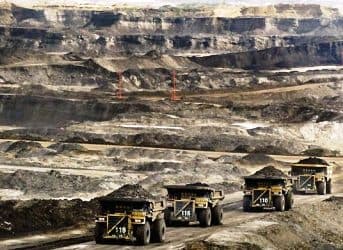The price oil sands producers receive fell to $48 a barrel below the international benchmark after a $4.50 or 21% widening to $25.00 of the spread between the price of Western Canada Select – a blend of heavy oil sands crude and conventional oil – and US crude.
The drop in Canadian heavy oil came as the US benchmark West Texas Intermediate (WTI) discount to the global oil price in the form of North Sea Brent widened to just under $23 – within shouting distance of the record margin of more than $26 in September 2011.
Brent settled at $107.93 in Europe on Wednesday which translates to an effective price for bitumen-derived oil from Alberta's oil sands of less than $60 a barrel.
The value of Syncrude, a light oil made from oil sands after undergoing an expensive upgrading process, also plunged on Monday to $0.75 above WTI from a $15.00 premium in September.
The lack of pricing power by Canada's oil sands players is often blamed on the fact that 99% of exports end up in the US – oil sands producers cannot access new markets in Asia as pipeline projects to the West coast languish in a regulatory morass.
There is no clear timeline for TransCanada’s (NYSE:TRP) Keystone XL to finally cross the border into Canada, that Enbridge’s (TSE:ENB) Northern Gateway pipelines is built at all is an ever diminishing prospect and even Kinder Morgan proposal to expand its existing pipeline going into Vancouver, is facing fierce opposition.
Apart from the east-west pipeline delays there is also the strange situation that the populous centers in the eastern part of the vast country import 60% of their needs and pay global prices. There is talk of converting an existing gas pipeline to carry Alberta oil to the east, but at this point that's all it is; talk.
And even if these projects do come off the ground Alberta producers like Suncor (TSX:SU NYSE:SU), Cenovus (TSX:CVE NYSE: CVE) and Imperial Oil (TSX:IMO NYSE:IMO) would still find it hard to compete.
Bitumen is expensive to extract, upgrade and refine and cannot compete with the many new shale oil plays which have pushed US production to its highest level in a decade.
Production in the US particularly from the Bakken basin – unlike WCC Bakken oil attracts a premium to WTI – in North Dakota will see the country ramp up current output of 7.8 million barrels/day to 10.9 million barrels over the next few years. Bakken is also competing for pipeline and refinery contracts with Alberta.
Apart from the boom in US production, and a strong currency, Alberta's oil sands players are also threatened by escalating costs according to a recent report by Wood Mackenzie that shows "break-even costs for building new steam-driven projects are in the $65-$70 a barrel range and mining developments need at least $90-$100 oil."
Existing project can still make money at $45 a barrel and at today's prices SAGD or steam-assisted gravity drainage projects still stand a chance to get off the drawing board, but a full fifth of oil sands projects – those that rely on conventional mining methods – are not nearly viable.
Just today a Canadian think-tank came up with new numbers to show the impact of the oil sands on Canada's economy:
Alberta’s oil sands will be responsible for creating 880,000 person-years of employment.
ADVERTISEMENT
Beyond the employment impacts, oil sands-related investment is expected to generate government revenues of $79.4 billion ($45.3 billion in federal revenues and $34.1 for provinces) between 2012 and 2035, on an inflation-adjusted basis.
If the current trend persists these figures may still prove far too optimistic.
By. Frik Els



















The president of the US is trying to bankrupt Canada in every way that he can. He has an innate animus toward the UK as well. Most puzzling, and a bit disgusting.
1) With billions of dollars at stake, the industry will not roll over. Pipelines or rail transport will be used to transport production to where it can reach Asian markets. And if the US wants to hold us back by supplying to China, they will chew through their resources even quicker.
2) The US will be cut-off of this opportunity and when they burn out their shale oil in 10-15 years, they will be at the mercy of China and India who will expand their influences in Canada.
3. Canada will build a pipeline East and add refinery capacity and become self-sufficient, halting imports of US oil.
4. The USA is not exactly strong on drinking water supplies with many States facing huge drouts in recent years. Aquifier levels are dropping.
5. What happens if there is an ecological disaster that causes fracking to be put on hold. There will be no Alberta oil available then...
6) Peak conventional oil is past. Putting all of their eggs in one basket will set the US up for the potential of paying even greater import costs should problems with supply occur at home. It is better for countries to have several sources of oil input as well as alternative (green) energy. Let the US put all of the eggs in their own basket, it will be at their short term gain only.
7. Canada will not let US play with us like a mouse -
"Put your oil on hold until we use all of ours up, maybe then we will talk..." No, no, no! We are hopefully not that naive as a country to let ourselves dry up economically to serve the needs of the American political drives.